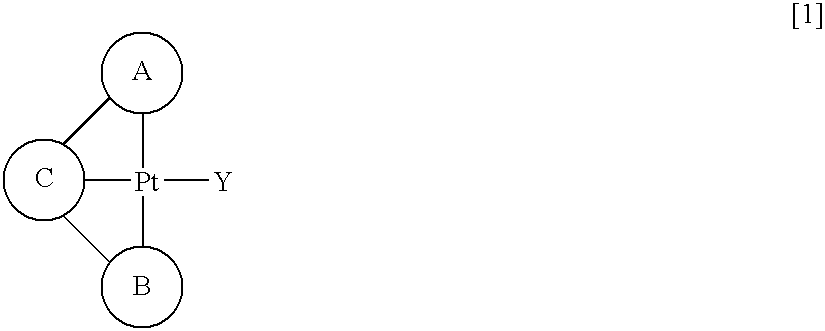Platinum complexes
a platinum complex and complex technology, applied in the field of platinum complexes, can solve the problems of not being able to predict with ease, not being able to achieve satisfactory yield, complex to light emitting devices such as organic el devices, etc., and achieves the effects of effective production method, excellent heat stability, and luminous efficiency
- Summary
- Abstract
- Description
- Claims
- Application Information
AI Technical Summary
Benefits of technology
Problems solved by technology
Method used
Image
Examples
reference example 1
Production of 1,3-di(2-pyridyl)benzene
[0197] The production was accomplished according to the following reaction formula in accordance with the description of Organometallics 1999, 18, p 3337 to p 3341).
[0198] 2.5 g of 1,3-dibromobenzene, 7.9 g of (2-pyridyl) tributylstannane, 0.60 g of bis (triphenylphosphine) dichloropalladium, 0.45 g of lithium chloride and 25 ml of toluene were mixed. The resulting mixture was stirred under reflux for 3 days. It was cooled to room temperature, followed by washing with water, and purified by a silica gel column chromatography. As a result, 1.4 g of the subject target compound was obtained as a colorless liquid.
[0199]1H-NMR (CDCl3): δ7.22-7.29 (m, 2H), 7.59 (t, J=7.8 Hz, 1H), 7.73-7.87 (m, 4H), 8.07 (dd, J=1.8 Hz, 7.8 Hz, 2H), 8.61-8.76(m, 3H).
reference example 2
Production of 1-fluoro-3,5-di(2-pyridyl)benzene
[0200] In the same manner as with Reference Example 1, 1.4 g of 1-fluoro-3,5-dibromobenzene, 5.0 g of (2-pyridyl)tributylstannane, 0.38 g of bis(triphenylphosphine)dichloropalladium, 0.28 g of lithium chloride and 14 ml of toluene were mixed. The resulting mixture was stirred under reflux for 3 days. It was cooled to room temperature, followed by washing with water, and purified by a silica gel column chromatography. As a result, 1.2 g of the subject target compound was obtained as a white solid.
[0201]1H-NMR (CDCl3): δ7.22-7.32 (m, 2H), 7.77-7.83 (m, 4H), 8.44 (t, J=1.4 Hz, 1H), 8.73 (dt, J=4.8 Hz, 1.6 Hz, 2H).
reference example 3
Production of 1-methoxy-2,4-di(2-pyridyl)benzene
[0202] In the same manner as with Reference Example 1, 5.0 g of 2,4-dibromoanisole, 6.9 g of (2-pyridyl)tributylstannane, 1.0 g of bis(triphenylphosphine)dichloropalladium, 0.8 g of lithium chloride and 50 ml of toluene were mixed. The resulting mixture was stirred under reflux for 3 days. It was cooled to room temperature, followed by washing with water, and purified by a silica gel column chromatography. As a result, 2.9 g of the subject target compound was obtained as a colorless liquid.
[0203]1H-NMR (CDCl3): δ3.92 (s, 3H), 7.09-7.27 (m, 3H), 7.67-7.87 (m, 4H), 8.11 (dd, J=2.6 Hz, 8.6 Hz, 1H), 8.37 (d, J=2.4 Hz, 1H), 8.64-8.74 (m, 2H).
PUM
| Property | Measurement | Unit |
|---|---|---|
| Time | aaaaa | aaaaa |
| Fraction | aaaaa | aaaaa |
| Fraction | aaaaa | aaaaa |
Abstract
Description
Claims
Application Information
 Login to View More
Login to View More - R&D
- Intellectual Property
- Life Sciences
- Materials
- Tech Scout
- Unparalleled Data Quality
- Higher Quality Content
- 60% Fewer Hallucinations
Browse by: Latest US Patents, China's latest patents, Technical Efficacy Thesaurus, Application Domain, Technology Topic, Popular Technical Reports.
© 2025 PatSnap. All rights reserved.Legal|Privacy policy|Modern Slavery Act Transparency Statement|Sitemap|About US| Contact US: help@patsnap.com



